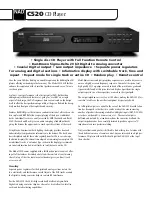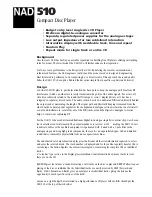
Chapter 6. Sound Settings
58
one channel and ends in the other. Therefore, four additional functions are provided to
move the stage back to the center:
Balance
to change the left-right channel output
ratio.
A bypass band for frequencies that mostly contain vocals, using
f(x1)
, and
f(x2)
to set frequencies which are not affected. The
SIDE ONLY
setting uses mid-side
processing to determine and apply effect to the side channel only. Finally, the
Dry/Wet
Mix
setting adjusts the proportion mixed from the original (dry) and ’effected’ (wet)
signals.
6.13. Perceptual Bass Enhancement
This setting implements a group delay correction and an additional biophonic EQ to
emphasize to boost bass perception. The
precut
setting provides negative overall gain
to prevent possible audio distortion due to the EQ gain. The defult precut value is set
to -2.5 dB and can be adjust from 0 dB to -4.5 dB. Note that this effect will stack with
any other EQ applied.
6.14. Auditory Fatigue Reduction
Human hearing is more senstive to some frequency bands. This setting applies additional
equalization and bi-shelf filtering to reduce signals in these bands to minimize the chance
that temporary threshold shift (auditory fatigue) occurs.
6.15. Compressor
The
Compressor
reduces, or compresses, the dynamic range of the audio signal. This
makes the quieter and louder sections closer to the same volume level by progressively
reducing the gain of louder signals. When subsequently amplified, this has the effect of
making the quieter sections louder while keeping the louder sections from clipping. This
allows listening to the quiet sections of dynamic material in noisy environments while
preventing sudden loud sections from being overbearing.
There are several settings associated with the compressor. The first, and most impor-
tant, is the
Threshold
. The threshold is the audio input level at which the compressor
begins to act. Any level louder than the threshold will be compressed to some extent.
The maximum amount of compression, or the quietest level at which the compressor will
operate, is -24 dB. The default of Off disables the compressor.
The
Makeup Gain
setting has two options: Off and Auto.
Off means that the
compressed audio will not be amplified after compression. The default of Auto will
amplify the signal so that the loudest possible signal after compression will be just
under the clipping limit. This is desirable because the compressed signal without makeup
gain is quieter than the input signal. Makeup Gain in Auto restores the signal to the
maximum possible level and brings the quieter audio up with it. This is what makes it
possible to hear the quieter audio in noisy environments.
The Rockbox manual
(version rUnversioned directory-150220)
Sansa e200 and e200R Series
















































